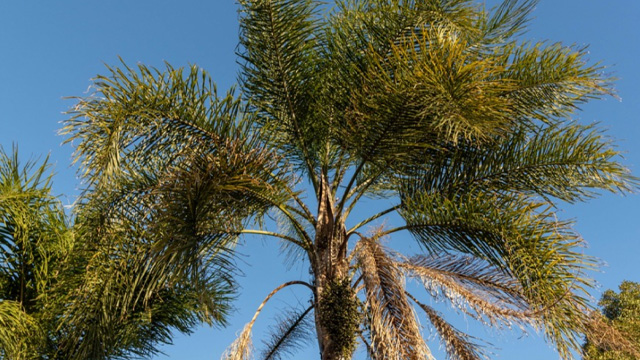Palm Selection and Care

Selecting the right palm for the right place is the first step in maintaining a healthy palm. Know how tall your palm you would like, will grow. Often palms are planted too close to buildings and then the fronds are sitting on the house or roof. This provides are great way for rats, ants and other creatures to make it onto your roof or into your home. Also, planting too close results in too many fronds being trimmed off palms.
Proper fertilization is also a key component to maintaining healthy palm trees. Most palms are planted in sandy, nutrient deficient soils which makes palms susceptible to nutritional deficiencies. Some of the most common would be potassium, magnesium, manganese and boron deficiencies.
To prevent this, use a good quality, slow release fertilizer with micronutrients such as Nurserymen Sure Gro 8-4-12. This fertilizer is acceptable for use on all landscape plants including lawn grasses, so avoid using lawn fertilizer within 50 feet of the palm trunk. Use the 8-4-12 instead.
Palms in this zone require fertilizing three times per year- Spring Summer and Fall. 1.5 pounds (or 13 cups) per 100 sq. feet of palm canopy area is the rate of application. Spread the fertilizer evenly around and if there are other plants in the beds it will help fertilize them as well.
Palm pruning is another misunderstood practice in palm maintenance. Palms are different than trees and most of them store their nutrients in the older, green fronds. When palms are “hurricane pruned” (removal of lower green fronds), it deprives the palm of stored nutrients and can result in severe deficiencies.
Removal of fronds also can expose the tender heart of the palm to winds and cold temperatures as well as “pencil pointing” of the trunk- which is the narrowing of the trunk where nutrition has been deprived. This can also cause the palm to snap off.
Brown of dead fronds can be removed throughout the season as well as flowers and seeds but green ones should only be removed when they are a danger or detriment.
Many palms like pygmy date palms (robebelini) and Sylvester Palms should have fronds that are at least parallel to the ground while others like Sabal Palms, should have “heads” that are almost 360 degrees or rounded.